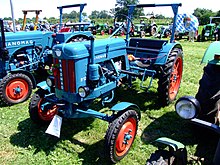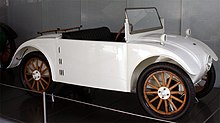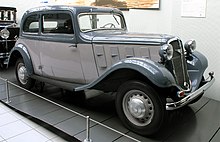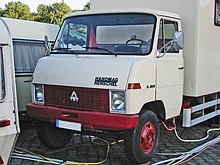Hanomag
This article includes a list of generalreferences,butit lacks sufficient correspondinginline citations.(January 2021) |
 | |
| Company type | Aktiengesellschaft |
|---|---|
| Industry | Locomotives,Tractors,Trucks, Motorcycles, Construction Machinery, Cars etc |
| Founded | 1871 |
| Defunct | 1984, 1990 & 2002 (various branches) |
| Fate | Merger, Dissolution |
| Headquarters | , |
Area served | worldwide |
Key people | Bethel Strousberg
Horst-Dieter Esch Alfred Massey Ferguson & Helmut Gassmann Günter Papenburg |
| Parent | Komatsu(Since 1990) |
| Website | www.komatsu-kohag.com |

Hanomag(Hannoversche Maschinenbau AG,German pronunciation:[ˈhano:mɐx]) was a German producer ofsteam locomotives,tractors, trucks and military vehicles inHanover.Hanomag first achieved international fame by delivering numerous steam locomotives toFinland,RomaniaandBulgariabefore World War I and making of first tractor Hanomag R26 in 1924 in Germany. In 1925, they added automobiles to their line, additionally moving in 1931 into the production of construction machinery. Since 1989, the company has been part of theKomatsucompany.
History[edit]

The company dates back to 1835 when Georg Egestorff founded in Linden near Hanover a company calledEisen-Giesserey und Maschinenfabrik Georg Egestorffto build smallsteam engines.They soon started makingfarm machineryand in 1846 built their firstrailway locomotivefor theRoyal Hanoverian State Railways.By 1870 they had made 500 locomotives and in 1871 changed their name toHannoversche Maschinenbau Actien-Gesellschaft vorm. Georg Egestorff, Linden vor Hannover.Road vehiclesfollowed when in 1905 they received a contract forsteam wagonsfor theGerman army.
Tractors[edit]



In 1912 Hanomag started the production of ploughs with up to 80-horsepower (59kW) benzene engines. In 1924, the first farm tractor WD 26 (WD) with a 26-horsepower (19kW) four-cylinder benzene engine was presented to the market. In 1931, the first diesel tractor RD 36 with a 36-horsepower (26kW) four-cylinder engine, and 5.2 litres (320 cubic inches) of capacity was made. Hanomag was the market leader in 1939 and the early 1950s. In 1951, a series of new tractors were developed, based on a modular system with 2-,3-, and 4-cylinder engines. From 1962 until the cessation of production in 1971, only four-stroke diesel tractors were built.
From 1912 to 1971, more than 250,000 machines from 12 to 92 horsepower (9 to 68kW) left the factory halls in Linden. In addition, there were manufacturing facilities in Argentina and license agreements with Spanish industrialists.
Cars[edit]


By the 1920s, the market for steam road vehicles was in terminal decline, and Hanomag looked to cars as the future, particularly economy models. In 1925, they launched theHanomag 2/10,a 370 kg (816 lb) open two-seater with a mid-mounted 500-cubic-centimetre (31-cubic-inch)[1]single-cylinder water-cooled engine. NamedZweisitzer Limousine(two-seat limousine)[2]by the company, its rounded front and rear gained it the nicknameKommissbrotfor its resemblance to a loaf of Army bread. Although made in large numbers, 15,775 in total, it did not make much money for the company and in the late 1920s the railway locomotive division was sold toHenschel & Sonof Kassel.
A more conventional car, the 3/16PS, and the first diesel-engined tractors, came in 1928, taking the company back into profit. Hanomag were badly hurt by the drop in trade in 1929 and built a large stock of unsold vehicles. Things improved in 1930 and the company got 14 per cent of the domestic car market, second place behindOpel,but in 1931 a new crisis came when the banks called in a loan. The factory was mortgaged to Hannover City and theVereinigte Stahlwerketrust and the company relaunched asHanomag Automobil und Schlepperbau GmbH.
For 1932, a new small car, the 1.1 Litre, renamed theGarantin 1934, was announced and sold well, allowing two-shift working to be introduced and it was joined by the larger 1.5 litreRekord(a name later used byOpel) in 1933, with independent front suspension. A diesel Rekord was shown at the 1936 Berlin Motor Show.[3]
The Hanomag 1.3 litre was introduced in 1939 and had unitary body, an innovative feature for that time. It was studied byVolvoengineers and influenced the construction of the VolvoPV 444passenger car.[4]
Military vehicles[edit]
DuringWorld War II,the car plant made military vehicle engines, a military version of their heavy tractor renamed the SS-100, andhalf track troop carriers.TheHanomag 20 B,a four-wheel-drive Small Unit-Personnel Carrier was produced from 1937 until 1940 (circa 2000 built) under the parentage ofStoewer(as the R180, R200 and Type 40). Capacity problems by Stoewer resulted in co-production by bothBMW(as the 325) and Hanomag.[5]Together, the three manufacturers made about 10,000 units. The special four-wheel-steeringsystem was fitted on most models. Operating a "lock-level" between the front seats, made the steerable rear axle turn sideways to a certain angle.[5]
The single most important and iconic military vehicle to be designed and built by Hanomag during World War II was theSd.Kfz. 251half-track (commonly called simply "the Hanomag" but this has been questioned, and may have been only a postwar label. German officers referred to them as SPW 'Schützenpanzerwagen, or armored infantry vehicle' in their daily orders and memoirs.) with a total production numbering just over 15,000. Built to protect and transport thePanzergrenadiermechanized infantry forces,it was by far the most common German armoured troop-carrying vehicle of World War II, and a direct precursor to thearmoured personnel carriersof today. In comparison to the most common Allied half-track of the war, theM3 Half-track,the Sd.Kfz. 251 was slower and lower-powered, but with thicker, sloping side armour provided better protection; the flat-sided M3 was, at one point, panned as the "Purple Heart Box" for being unable to stop7.92mm Mauserbullets at close range, while the Hanomag's sloping side armour deflected Allied bullets with no similar issue.[citation needed]
Post-war production resumed, making trailer units, followed by tractors and, in 1949, a 1.5 ton truck. Although prototypes were made, no cars were produced postwar. Rudolph Hiller, who had been president ofPhänomentrucks, joined the board and restructured the company by arranging for it to join theRheinstahlconsortium in 1952.
Merger and split[edit]

In 1964,Rheinstahltook overHenschel-Werkeand in a reverse of history the company was merged with Hanomag.

The farm tractor operation was sold toMassey Fergusonand in 1969 the truck making division of Hanomag-Henschel went toDaimler Benz,leaving the Hanover works making earth-moving machinery for Massey Ferguson.
In 1989, the world's second largest construction machine manufacturer,Komatsu,bought a share of Hanomag AG and, since 2002, Komatsu Hanomag GmbH has been a 100% subsidiary of the global company.
Construction machinery[edit]

In Hanover, the company is producing wheel loaders ranging from 54 to 353 hp (263 kW) and since 2005 also has been producing wheeled excavators from 14 to 22 tons. Thanks to the European Technical Center (EUTC), these correspond to the latest state of technology. In Hanover, the company develops construction machines which meet varied requirements of customers all over Europe as well as for certain products also worldwide.
Hanomag in Argentina[edit]
In 1960, Cura Hnos began to build a billet factory from an electric furnace on the premises, which he later suspended for associating with Rheinstahl Hanomag, from Germany, to manufacture tractors. The new company by the merger, used the industrial warehouse of Granadero Baigorria, while the administration and factory of the new company was built.
Models produced
See also[edit]
- Eicher tractor
- Lanz Bulldog
- Daimler-Benz
- Tempo
- Force Motors,formerly Bajaj Tempo, produced Hanomag products in India.
References[edit]
- ^G.N. GeorganoCars: Early and Vintage, 1886-1930.(London: Grange-Universal, 1985)
- ^G.N. Georgano.
- ^Oswald, Werner[in German](1979),Deutsche Autos 1920-1945 – Alle deutschen Personenwagen der damaligen Zeit(in German) (3rd ed.), Stuttgart: Motorbuch-Verlag, p. 135,ISBN978-3-87943-519-7
- ^"1944: The body, imprisoned (in Russian)".
- ^abOdin, L.C. (2015),World in Motion 1939, The whole of the year's automobile production,Belvedere Publishing,ASINB00ZLN91ZG
- ^Dl, Esteban (9 February 2017)."Pesados Argentinos: Hanomag R40 RCE / R40 RCT".
- ^Dl, Esteban (9 February 2017)."Pesados Argentinos: Hanomag R46".
- ^Dl, Esteban (9 February 2017)."Pesados Argentinos: Hanomag R55".
- ^Dl, Esteban (9 February 2017)."Pesados Argentinos: Hanomag R57 Brillant".
- ^Dl, Esteban (9 February 2017)."Pesados Argentinos: Hanomag R60".
- ^Dl, Esteban (9 February 2017)."Pesados Argentinos: Hanomag R75".
